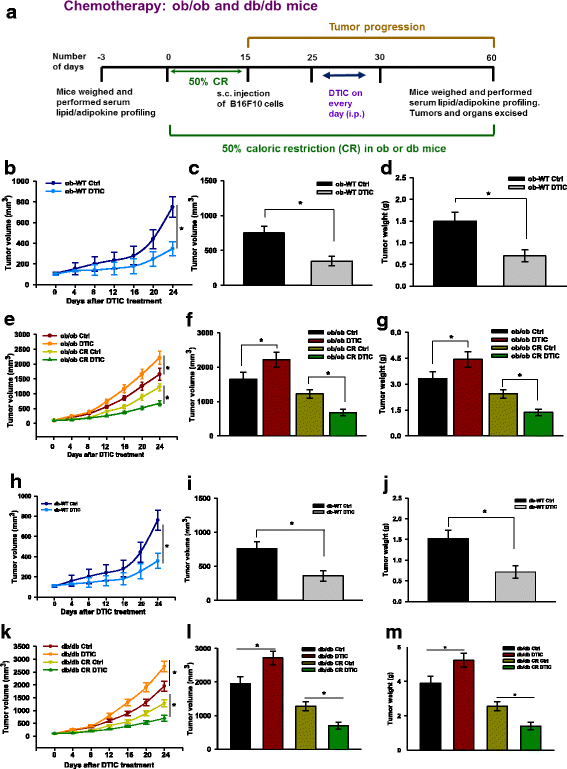Elevated circulatory levels of leptin and resistin impair therapeutic efficacy of dacarbazine in melanoma under obese state
- PMID: 29568521
- PMCID: PMC5859707
- DOI: 10.1186/s40170-018-0176-5
Elevated circulatory levels of leptin and resistin impair therapeutic efficacy of dacarbazine in melanoma under obese state
Abstract
Background: Obesity is associated with increased risk, poor prognosis and outcome of therapy, in various cancers. Obesity-associated factors or adipokines, especially leptin and resistin, are purported to promote growth, survival, proliferation, and invasiveness of cancer cells. However, the mechanistic link between these adipokines and therapeutic response in malignancies is not clearly understood.
Methods: ob/ob and db/db mouse models were used in this study to evaluate the role of leptin and resistin towards the outcome of dacarbazine (DTIC) therapy in melanoma. Unique in vitro approaches were employed to complement in vivo findings by culturing melanoma cells in the serum collected from the experimental mice.
Results: Here, we have shown the role of important adipokines leptin and resistin in growth and the outcome of DTIC therapy in melanoma. Both leptin and resistin not only enhance proliferation of melanoma cells but also are involved in impairing the therapeutic efficacy of DTIC. Leptin and resistin treatment caused an increase in the protein levels of fatty acid synthase (FASN) and caveolin 1 (Cav-1) respectively, through their stabilization in A375 cells. Further, it was observed that leptin and resistin impaired the response of melanoma cells to DTIC via upregulation of heat shock protein 90 (Hsp90) and P-glycoprotein (P-gp) respectively.
Conclusion: These findings unraveled the involvement of adipokines (leptin and resistin) in melanoma progression, and more importantly, in the outcome of DTIC therapy.
Keywords: Chemotherapy; Leptin; Melanoma; Obesity; Resistin; Weight-control interventions.
Conflict of interest statement
All animal experiments were carried out as per the requirement and guidelines of the Committee for the Purpose of Control and Supervision of Experiments on Animals (CPCSEA), Government of India, and after obtaining the permission of the Institutional Animal Ethics Committee (IAEC).Not applicableThe authors declare that they have no competing interests.Springer Nature remains neutral with regard to jurisdictional claims in published maps and institutional affiliations.
Figures





References
LinkOut - more resources
Full Text Sources
Other Literature Sources
Miscellaneous

